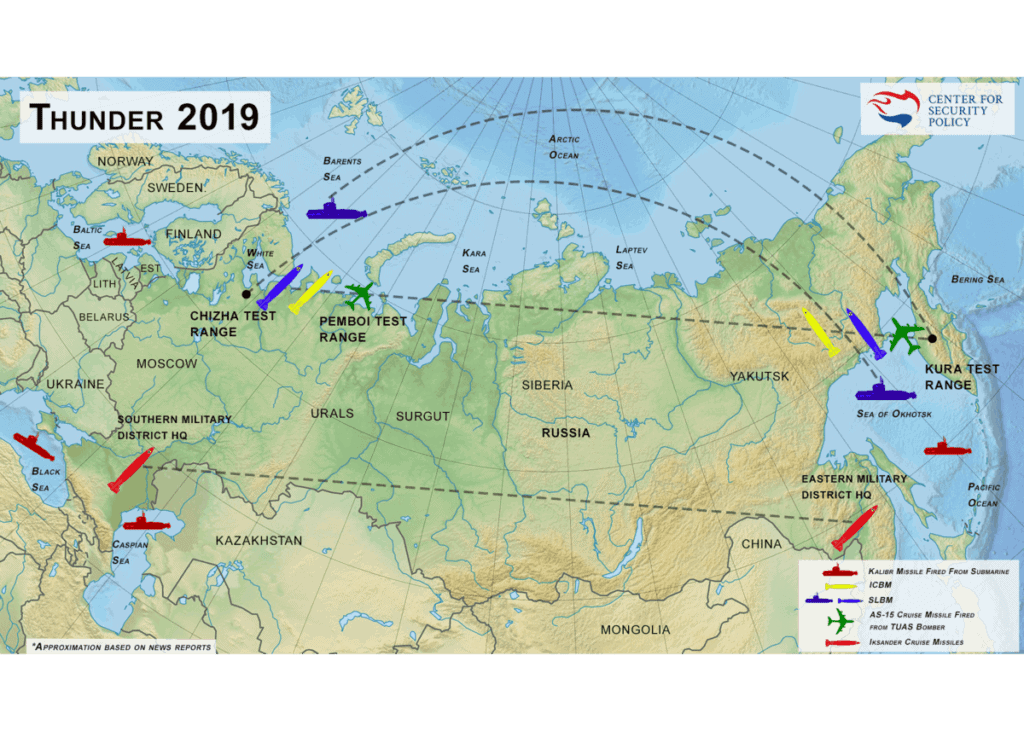Russia Practices Massive Strategic Nuclear Attack During Thunder-2019
“This is the largest Russian strategic nuclear exercise in decades. It actually, in some respects, exceeds almost anything we’ve seen during in the later stages in the Cold war”

 Map is based on reporting from Tsar Grad, The Diplomat, Express.co, AP and The Barents Observer.
Map is based on reporting from Tsar Grad, The Diplomat, Express.co, AP and The Barents Observer.
Last week, Russia practiced the final stage of a nuclear war during the Thunder-2019 nuclear exercise.
The purpose of the exercise was to test command structure and included 12,000 troops, five nuclear submarines, 105 aircraft, 15 surface ships, and 213 missile launchers, according to the Kremlin.
Land and submarine-based ballistic missile were launched, in addition to air, ship, and land-based cruise missiles. Tsar Grad claim 16 ballistic and cruise missiles were launched in total. President Vladimir Putin presided over the final stages of the exercise.
While Russia holds nuclear exercises every year, Thunder-2019 was unusual.
“This is the largest Russian strategic nuclear exercise in decades. It actually, in some respects, exceeds almost anything we’ve seen during in the later stages in the Cold war,” said Dan Goure, Senior Vice President of the Lexington Institute.
“Not only is it sort of the practice drill for what would be a systematic, massive attack on the United States and on targets around the world, but also demonstrated all the new toys that the Putin administration has been producing,” Goure continued.
Despite Kremlin claims, the exercise was not flawless. During the drill, a submarine fired only one ballistic missile instead of two, and another warship had to use the backup launch system for a Kalibr cruise missile.
In addition to size, the level of detail released is unique.
“I have never seen such a level of detail in announcements of Russian strategic nuclear exercises. They always stated the number of live launches but they never gave out information about the number of missiles, bombers and missile submarines involved in the exercise,” said Dr. Mark Schneider Senior Analyst at the National Institute for Public Policy.
“At a minimum, this was one of the largest they have ever staged. In the past, I got the impression that the past exercise was mainly command related with a significant number of live launches. This seems to have been much beyond that,” Schneider said.
Thunder-2019 could be intended to intimidate the West into preservation of the New START Treaty –set to expire in 2021. New START is likely dead after President Trump’s withdrawal from the INF Treaty.
A few days before Thunder-2019, Putin accused NATO of ignoring his offer of a moratorium on the deployment of short and intermediate missiles in Europe. NATO rejected the offer, and refused negotiations unless the Russians destroyed the SSC-8 in a verifiable way.
The Russian Iskander SSC-8 cruise missile was developed and deployed in violation of the INF Treaty. Moscow claimed SSC-8 did not have an improved range.
Moscow has historically cheatedon arms-control treaties, continuing nuclear advancement, while Washington complies and falls behind.
Since INF withdrawal, Putin has vacillated between threatening nuclear war, flaunting nuclear capabilities and offering peace. Either way, Putin paints Washington as the aggressor.
Putin is likely hoping that American arms-control enthusiasts will push for restraint, lest the U.S. provoke Russia into nuclear war. The pro arms-control crowd have indeed echoed Kremlin claims that U.S. nuclear modernization will set of an “arms race.” They will claim appeasement is the only way to prevent dangerous escalation.
Russian cheating was not Trump’s only reason for withdrawal from the INF Treaty, however. China’s nuclear stockpile is set to double over the next decade and must be included in future agreements, possibly making Putin’s intimidation tactics a Soviet-relic incapable of revival.
- 51 percent of Americans believe the world is less stable since President Biden took office - March 28, 2022
- Biden’s weakness will result in aggression - August 23, 2021
- Democrats join European lawmakers in opposing Biden’s Nord Stream 2 Deal - August 2, 2021
